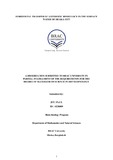Horizontal transfer of antibiotic resistance in surface water of Dhaka City
Abstract
Horizontal gene transfer is one of the most widespread phenomenon by which bacteria evolve themselves in the environment. Such transfer is often reported to be responsible for spreading antibiotic resistance genes in nature. This study was designed to understand the significance of natural transformation among different bacterial species in the surface water of Dhaka city in the light of emergence of antibiotic resistance; Salmonella sp. and Klebsiella sp. were used as model donor and recipient respectively. A total 10 environmental Salmonella isolates and 5 potential recipients (ATCC strains) were collected from BRAC University Microbiology Lab. By using Kirby-Bauer Disk Diffusion method, donor and recipient strains were selected. Among the 10 Salmonella isolates, 3 (Salmonella GL6.2, Salmonella HJ & Salmonella HJ3.1) showed highest number of resistant against 9 different antibiotics and these isolates were considered as a highly resistant donor for this experiment. Whereas, among those 5 ATCC stains, Klebsiella variicola showed highest level of sensitivity against 9 different antibiotics and this strain was selected for this study. After the antibiotic susceptibility test was done, the chromosomal DNA (boiling method) and plasmid DNA (Kado-Liu method) of the donor Salmonella strains were extracted for bacterial natural transformation experiment. Obtained results indicate that, the rate of chromosomal DNA mediated transformation is higher than plasmid DNA mediated transformation between Salmonella spp. and Klebsiella variicola. Further, it has been found that among the two matrices tested in this study (waters from Hatirjheel and Gulshan lakes), bacterial transformation is higher in Gulshan Lake; 34 successful transformed-bacterial cell growth found on antibiotic containing LB plates out of 90 different cases as opposed to 23 successful transformed-bacterial cell growth in Hatirjheel surface water. Further assays indicate that transfer of antibiotic resistance mostly involves chromosomal DNA-mediated transformation. Overall, this study reveals that horizontal gene transfer in surface waters could be one of the significant factors behind the rise of antibiotic resistance in Dhaka.

